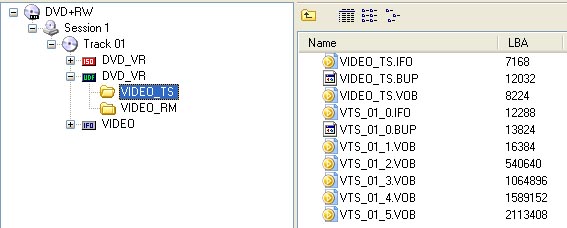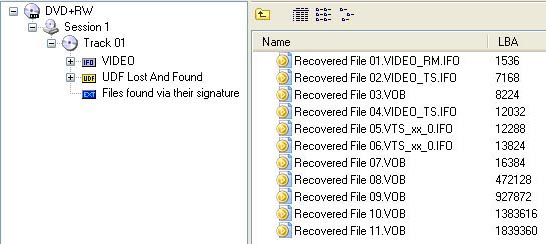How to recover VIDEO files and data from DVD with IsoBuster
Before we start I should point out that IsoBuster does not work around DVD Video copy protections such as CSS. In other words, IsoBuster won't be able to extract data from commercial DVDs unless you are allowed to do so and have the right equipment and/or software.
If your home made Video-DVD is bad and not playing anymore in your standalone player and/or PC and you are at lost what to do, then recovering the data (or what is left of it) with IsoBuster can be a life saver.
This article, to a certain extent, overlaps with this help file article about recovering data with IsoBuster. It's worth, even recommended, reading the help file article first because it goes into certain areas that are not covered here. Things that don't make sense will hopefully become more clear when you read this article afterwards. This article also assumes that you are more or less familiar with the use of IsoBuster, e.g. that you know it's right-mouse-click oriented and that you know how to "extract" data from a DVD.
So let's get started
After you pop in the DVD in your drive and have IsoBuster mount the disc you will likely see something like this:

A Video DVD consists of one track in one session. That track typically contains more than one file-system, and each of those file-systems is pointing to the files. If you only see a session and a track, no file system(s), don't panick, we will cover that as well, just keep reading, all the information you can read here is relevant as well.
In the example you can see that the ISO9660 (red icon), UDF (blue/green icon) and Video-native (grey icon) file-systems could be found immediately. IsoBuster always lists all file-systems it can find to give you multiple ways to get to the data. A file-system is the structure that points to all the files and folders on a disc.
The different file systems, especially on Video DVD, may not all appear to be the same, especially the DVD-native file-system (based on IFO file content) may differ from the other file-systems sometimes. E.g. some files may appear larger etc. That is not a problem. And if ultimately one file-system gives you problems, you can try the other one, that is why they are all listed.

When you click a file-system, say the blue/green UDF file-system, then you will see its content appear in the right hand side pane. A Video DVD can contain multiple directories and content but we are now after the VIDEO content.
Re-create a Video DVD from a complete set of IFO, BUP and VOB files
A Video DVD contains a VIDEO_TS folder that contains a set of IFO, BUP and VOB files. The big VOB files contain the actual video. The BUP files are copies of the IFO files, and they contain information for your video player. Should the actual files be missing on your disc, then please read further where we will ultimately be looking for missing data.
In the case that this folder is intact and all files seem readable, and this is a properly finalized disc, then you can extract the full VIDEO_TS folder. E.g. right mouse click the folder in the left hand side pane and choose "extract". When this is successful, either after a flawless extraction or after having to replace bad sectors with all zeroes from time to time, you have the full DVD on your hard drive. Note that only VOB files can survive with some null-byte sectors, not IFO nor BUP files. It is now possible to play the full DVD by starting up your PC based DVD Video player (e.g. Power DVD) and have it play the VIDEO_TS.IFO file.
If you want to re-create a Video DVD from this content, read following article:
Previous information is most relevant if the full VIDEO_TS folder is available and readable, and if the information in the folder is correct, which may be hard to verify before you start. For one the disc must have been finalized properly, so that all IFO and BUP files were created/updated properly, otherwise there is no use for them. Above information may already be enough for your recovery but if you want to avoid an IFO/BUP mess, if you are not interested in remastering a new DVD, if the DVD was not properly finalized, if all you want is an mpg file with your video, then read on.
Re-author a Video DVD from recovered VOB files, or better yet, convert them to MPG files
In the above example all three most common file-system were immediately found. It is however also possible that only one or none at all are found. In the following example only the DVD-native IFO based file-system could be found:

This file-system also points to a VIDEO_TS folder and the same approach as in the first example can be followed.
There is an important extra feature available in IsoBuster for the so called +VR and -VR discs which are VIDEO discs created by standalone writers (but also Nero for instance can make them) on DVD+R/-R or DVD+RW/-RW discs.
IsoBuster can identify the different recordings on such discs, if they are to be found, and lists them in the folder: "+-VR Video recordings". This folder will typically show each recording in a separate VOB file. Larger recordings may be cut into two or more (smaller than 1 GB) files, depending on your settings. In the example three different shows were recorded at different times with a standalone player:

The file-names are given by IsoBuster itself unless recorded ones could be found.
These VOB files, once extracted to HD, can be played with your MPG or DVD Video playback software on your PC and so you are able to watch the lost video.
In another and last example no file-systems could be found straight away. So only a session and a track, but no files whatsoever. After a scan for missing files and folders however, some of the file-systems could be found again:

If a found file-system is the (grey icon) DVD-native file-system, or an ISO9660 file-system (not shown in this example) or a complete UDF file system (not shown either), and a full set of IFO, BUP and VOB files can be extracted, then you can re-create the Video DVD as explained in first example.
If only files from the "UDF lost and found", "+-VR Video recordings", or ultimately "Files found based on their signature" can be found then you should recover only the VOB files, see further.
Putting the resulting data back on a true Video DVD which is playable by a standalone player is something else. Because these files lack the extra and matching IFO and BUP files that are needed to recreate the Video DVD easily. Extra handling is needed to prepare the data so that it can be burned to DVD. In fact there are different ways to go about this:
- Re-author the DVD using DVD Video authoring software to re-encode the video stream and make menus etc. For instance:
- With Nero Vision: How to re-author a DVD from one or more VOB files on my hard drive?
- With ConvertXtoDVD: Re-create a Video DVD from one or more recovered VOB files.
- Make use of the free tools IfoEdit and VobEdit to make a playable set of IFO, BUP and VOB files on your HD. This is for the more advanced among us, see:
- With IfoEdit/VobEdit: How to re-create a DVD from one or more VOB files on my hard drive?
- Extract the VOB files to pure MPG files, via right mouse click "Extract but filter only Mpg frames". Or extract them normally as VOB files and convert to MPG afterwards. You can use these pure MPG files as input for any of the mentioned DVD authoring options (See above) or you can simply put the pure MPG files on a standard data DVD. These days most Video players accept normal data DVDs as well, they don't need to be 'Video DVDs' authored with one of the tools mentioned above. Just the mpg file on the disc is usually enough to simply play the Video content. And any simple (free) DVD writing program, for instance ImgBurn, or the OS itself, can put the mpg file(s) on a DVD for you.
The latter method of course doesn't have menus, so if you want the more fancy Video DVD features, you need to use re-authoring software. This is not always cheap and not all software reacts the same way on flaws in VOB files. So you better start with pure MPG files, created via "Extract but filter only Mpg frames" for instance. When VOB files contain flaws due to read errors or other issues, some programs give up. There is no golden rule, some fail on 'this and some on 'that'.
You may always share your own expertise and experience to help improve these articles.